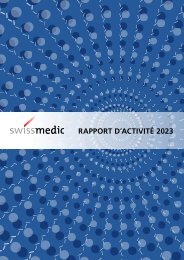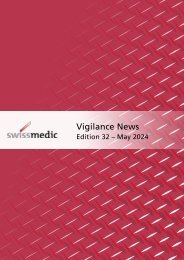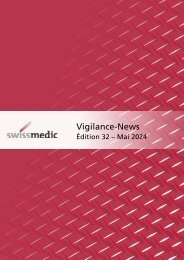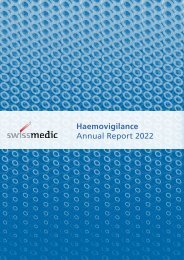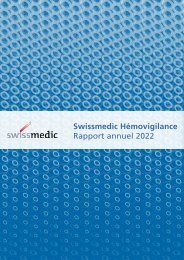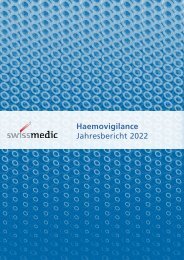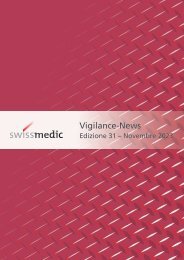Swissmedic Vigilance News Edition 21 – November 2018
In this edition: Isotretinoin and DOAC – Updates Confusion between amphotericin B formulations Guest articles: RPVC Zurich and RPVC Ticino Quality Assurance in Transfusion Practice Statistical Review 2017
In this edition:
Isotretinoin and DOAC – Updates
Confusion between amphotericin B formulations
Guest articles: RPVC Zurich and RPVC Ticino
Quality Assurance in Transfusion Practice
Statistical Review 2017
Create successful ePaper yourself
Turn your PDF publications into a flip-book with our unique Google optimized e-Paper software.
In order to highlight the risk of confusion,<br />
the Swiss Information for healthcare professionals<br />
for Fungizone ® already contains the<br />
following warnings:<br />
"Multiple parenteral forms of the active substance<br />
amphotericin B exist. Please check the<br />
preparation name and dosage before use.<br />
Caution during Fungizone dosing: Under no<br />
circumstances should a total daily dose of 1.5<br />
mg/kg body weight be exceeded. An overdose<br />
can result in potentially fatal cardiac or<br />
respiratory arrest."<br />
In view of the higher permitted dosage of<br />
AmBisome ® , the problem of overdose arises<br />
when Fungizone ® is administered at the Am-<br />
Bisome ® dosage. By contrast, using AmBisome<br />
® instead of Fungizone ® can lead to underdosage.<br />
The product information for Am-<br />
Bisome ® explicitly refers to this in the dosage<br />
section:<br />
"Since the dosage of AmBisome is productspecific<br />
it may NOT be applied to other medicines<br />
containing amphotericin B."<br />
Case reports<br />
The product information texts and packaging<br />
elements of Fungizone ® and AmBisome ®<br />
already include sufficient references to the<br />
risk of confusion and the associated risk of<br />
overdose. Nevertheless, there are two<br />
known cases in Switzerland where the dosage<br />
recommendations for liposomal amphotericin<br />
B were applied to the administration<br />
of non-liposomal amphotericin B.<br />
In 2015, a 39-year-old woman received an<br />
overdose with non-liposomal amphotericin<br />
B, resulting in multiple life-threatening<br />
events (ventricular tachycardia, cardiac arrest,<br />
hyperkalaemia, acute kidney injury,<br />
liver cell damage, haemolytic anaemia and<br />
thrombocytopenia). By the time of the report,<br />
the patient had recovered from the<br />
cardiac arrest and hyperkalaemia, but not<br />
from the acute liver damage, haemolytic<br />
anaemia or thrombocytopenia.<br />
In a case from Switzerland published in 2016,<br />
an immunosuppressed 9-year-old boy recovering<br />
from a bone marrow transplant suffered<br />
diarrhoea, vomiting, acute renal failure,<br />
fever and shivering as a result of an amphotericin<br />
B overdose. The patient had been<br />
given Fungizone ® instead of the prescribed<br />
intravenous AmBisome ® . Consequently, the<br />
patient had received ten times the recommended<br />
dose. After rehospitalisation and<br />
several weeks of treatment, the child recovered<br />
completely (6).<br />
Conclusion<br />
The purpose of a Direct Healthcare Professional<br />
Communication (DHPC), formerly<br />
termed a Dear Doctor Letter (DDL), is to inform<br />
health professionals about important,<br />
newly identified drug risks <strong>–</strong> particularly if<br />
these are unexpected <strong>–</strong> and corresponding<br />
risk minimisation measures, with a view to<br />
prompting a relevant change in approach. In<br />
this case, the product information texts and<br />
packaging elements for the drugs concerned<br />
already contained sufficient references to<br />
the risk of confusion and thus the associated<br />
risk of overdose. The risk of confusion is<br />
known in professional circles and published<br />
in the literature. The information in these<br />
texts should already have been taken into<br />
account by the treating professionals. In this<br />
specific case, <strong>Swissmedic</strong> is therefore not<br />
sending out a DHPC, but would like to remind<br />
professionals of the risk of mix-ups between<br />
non-liposomal and liposomal parenteral<br />
forms of amphotericin B. Since the dosage<br />
of amphotericin B preparations is product-specific<br />
it may not be applied to other<br />
medicines containing amphotericin B. In<br />
view of the parallel use of different amphotericin<br />
B solutions in hospitals, measures<br />
should be taken to make it impossible, or at<br />
least more difficult, to confuse these preparations.<br />
<strong>Swissmedic</strong> <strong>Vigilance</strong> <strong>News</strong> | <strong>Edition</strong> <strong>21</strong> <strong>–</strong> <strong>November</strong> <strong>2018</strong> 13 | 39




